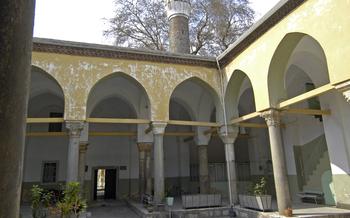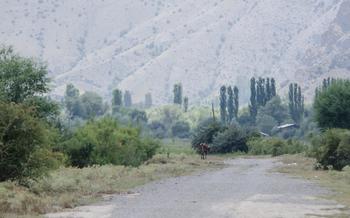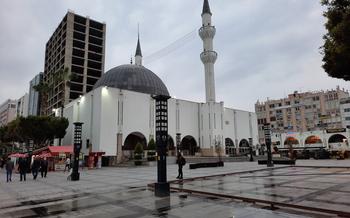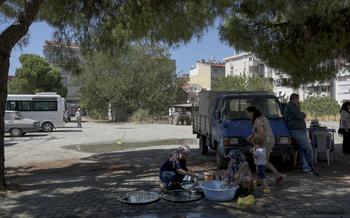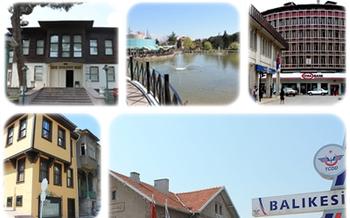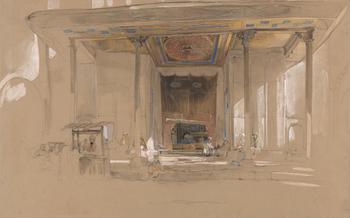
The Big Mosque (Ulu Cami) of Balıkesir
- The Big Mosque (Ulu Cami) of Balıkesir: A Masterpiece of Ottoman Architecture
- Stepping into History: The Foundation of the Ulu Cami
- Unveiling the Architectural Splendor
- Exploring the Spiritual Significance
- A Journey Through Time: The Evolution of the Ulu Cami
- The Ulu Cami's Enduring Legacy
- A Place of Serenity and Reflection
- Witnessing the Call to Prayer
- A Glimpse into Islamic Art and Culture
- A Place of Gathering and Community
- Experiencing the Local Traditions
- Practical Information for Visitors
- Capturing the Beauty: Photography at the Ulu Cami
- A Photographer's Paradise
- Nearby Attractions and Activities: Exploring Balıkesir's Charm
- Insider Tip: Unveiling the Hidden Gem
The Big Mosque (Ulu Cami) of Balıkesir: A Masterpiece of Ottoman Architecture
The Ulu Cami (Grand Mosque) of Balıkesir stands as a testament to the grandeur and artistry of Ottoman architecture. Built in the 15th century, this magnificent mosque has served as a spiritual and cultural landmark for centuries. Its historical significance is deeply intertwined with the rise of the Ottoman Empire, as it was commissioned by Sultan Murad II during his reign.
Architecturally, the Ulu Cami exhibits a harmonious blend of traditional Ottoman elements and regional influences. The mosque's exterior is adorned with intricate stone carvings and decorative tiles, showcasing the exceptional craftsmanship of the period. The interior features a vast prayer hall supported by elegant columns, creating a sense of awe and serenity. Its unique features, such as the intricately designed mihrab (prayer niche) and the ornate minbar (pulpit), further enhance the mosque's architectural splendor.
The Ulu Cami holds immense cultural importance for the people of Balıkesir. It serves as a symbol of the city's rich heritage, attracting visitors from near and far who come to admire its beauty and experience its spiritual aura. The mosque's historic significance and architectural grandeur make it a must-visit destination for anyone seeking to delve into the cultural tapestry of Turkey.
Stepping into History: The Foundation of the Ulu Cami
The Ulu Cami of Balıkesir stands as a testament to the grandeur and architectural prowess of the Ottoman Empire. Its foundation stone was laid in 1400 during the reign of Sultan Bayezid I, a period marked by significant expansion and consolidation of Ottoman power. The choice of Balıkesir as the site for this grand mosque reflects the city's strategic importance as a gateway to the Aegean region.
The construction of the Ulu Cami was overseen by the renowned architect Sinan, who is widely regarded as one of the greatest architects in Islamic history. Sinan's genius is evident in the mosque's harmonious proportions, intricate details, and innovative structural techniques. The Ulu Cami was completed in 1403, becoming a symbol of the Ottoman Empire's growing influence and devotion to Islam.
The location of the Ulu Cami is of great significance. It is situated in the heart of Balıkesir's historic center, surrounded by other important landmarks such as the city walls and the Balıkesir Archaeological Museum. This placement underscores the mosque's role as a focal point of religious, cultural, and social life in the city.
The Ulu Cami's legacy is intertwined with the history of Balıkesir. Over the centuries, it has witnessed countless events, from grand celebrations to moments of turmoil. Its endurance through these times speaks to the resilience and adaptability of the mosque and the community it serves. The Ulu Cami stands as a reminder of Balıkesir's rich past and its enduring spirit.
Unveiling the Architectural Splendor
In terms of architectural grandeur, the Ulu Cami stands as a testament to the artistry and skill of Ottoman builders. Its exterior façade captivates with its intricate stonework, featuring elegant arches, decorative moldings, and elaborate carvings. The towering minaret, adorned with intricate tilework, rises majestically into the sky, symbolizing the mosque's presence and prominence in the cityscape.
Stepping inside, visitors are greeted by a breathtaking display of Islamic architecture. The vast prayer hall, supported by rows of slender columns, creates a sense of spaciousness and awe. The mihrab, the niche indicating the direction of Mecca, is adorned with intricate tilework and calligraphy, serving as the focal point of the mosque's interior.
One of the unique features of the Ulu Cami is its exquisite dome. Constructed using the traditional brick and mortar technique, the dome's interior is adorned with vibrant frescoes depicting scenes from the Quran and Islamic history. The play of light filtering through the stained-glass windows illuminates the dome, creating a mesmerizing kaleidoscope of colors.
The Ulu Cami is not merely an architectural marvel but also a symbol of cultural and religious significance, standing as a testament to the rich history and heritage of Balıkesir.
Exploring the Spiritual Significance
The Ulu Cami serves as a pivotal place of worship for the Muslim community in Balıkesir. Its spacious prayer hall provides a serene environment where worshippers can connect with their faith and engage in religious rituals. The mosque holds a significant position in the spiritual lives of locals, who gather here to perform daily prayers, observe religious festivals, and seek spiritual guidance.
The mosque's religious significance is further amplified by the presence of a dedicated team of imams who lead prayers, deliver sermons, and teach Islamic principles. These religious leaders play a crucial role in fostering a sense of community and belonging among the worshippers. They organize religious classes, workshops, and events to promote Islamic education and foster a deeper understanding of the faith.
The Ulu Cami's spiritual significance is palpable to visitors, who can witness the reverence and devotion of the worshippers. The mosque exudes an aura of tranquility and spirituality, inviting visitors to pause, reflect, and connect with their inner selves. Whether you are a Muslim or not, the mosque's sacred ambiance offers a unique opportunity for spiritual exploration and contemplation.
A Journey Through Time: The Evolution of the Ulu Cami
The Ulu Cami, a testament to its enduring legacy, has undergone several changes and modifications over the centuries, reflecting the passage of time and the evolving needs of the community. These transformations, shaped by historical events and architectural trends, have added to the richness and depth of the mosque's story.
The Ulu Cami has stood resilient through earthquakes and renovations, each leaving their mark on its structure. The addition of minarets, the expansion of the prayer hall, and the incorporation of new decorative elements have contributed to its architectural evolution. These changes not only reflect the changing tastes and preferences of successive generations but also serve as a reminder of the mosque's adaptability and resilience.
Despite the changes it has undergone, the Ulu Cami has remained faithful to its original purpose as a place of worship and community gathering. The continuity of its function, amidst the ebb and flow of history, speaks to the enduring significance of the mosque in the lives of Balıkesir's residents. The Ulu Cami stands as a symbol of the city's rich past, a testament to the enduring power of faith, and a reminder of the timeless beauty of Islamic architecture.
The Ulu Cami's Enduring Legacy
The Ulu Cami stands as a testament to Balıkesir's rich history and cultural heritage. It is a symbol of the city's deep-rooted Islamic traditions and a source of pride for the local community. The mosque's enduring legacy is reflected in its continuous use as a place of worship, its role in shaping the city's identity, and the reverence it inspires among locals.
The Ulu Cami is a beloved landmark that holds a special place in the hearts of the Turkish people. It is a symbol of their faith and a reminder of the rich cultural traditions that have shaped their nation. Visitors to the mosque are often struck by the sense of awe and reverence that permeates the air, a testament to the enduring legacy of this architectural masterpiece.
The Ulu Cami's architectural beauty and historical significance have made it an iconic symbol of Balıkesir. It is featured prominently in postcards, tourist brochures, and travel guides, attracting visitors from around the world. The mosque's unique features and symbolic importance have made it a symbol of the city's rich cultural heritage, a heritage that the local community takes great pride in preserving and showcasing.
The Ulu Cami is a living testament to the enduring power of faith and the resilience of cultural traditions. It stands as a symbol of continuity and stability in a world that is constantly changing. The mosque's legacy is one of devotion, community, and architectural excellence, a legacy that is sure to continue for generations to come.
A Place of Serenity and Reflection
In the midst of the bustling city of Balıkesir, the Ulu Cami stands as an oasis of tranquility and reflection. Stepping inside, visitors are transported to a realm of serenity, where the noise of the outside world fades away. The spacious interior, bathed in a soft, ethereal light, invites contemplation and introspection.
The air within the mosque is charged with a palpable sense of peace. Worshippers and visitors alike find solace and comfort in the serene atmosphere. It is a place where one can escape the hustle and bustle of everyday life, seeking respite from the relentless demands of the modern world.
Whether you are a devout Muslim seeking spiritual connection or a curious traveler seeking a moment of tranquility, the Ulu Cami offers a sanctuary for contemplation and reflection. It is a place where the soul can find solace and rejuvenation, amidst the beauty and serenity of Islamic architecture.
Witnessing the Call to Prayer
As the sun begins its descent, casting a warm glow over the city of Balıkesir, a mesmerizing sound fills the air – the call to prayer, or ezan, from the minarets of the Ulu Cami. This powerful and evocative chant, recited by the muezzin, reverberates through the streets, summoning the faithful to gather for their evening prayers.
The ezan, with its melodic verses and rhythmic intonations, is a symbol of Islamic devotion and a reminder of the deep spiritual connection that exists within the Muslim community. As the muezzin's voice rises and falls, it creates a sense of unity and harmony among the believers, who respond to the call with a resounding "Allahu Akbar" (God is great).
Witnessing the call to prayer at the Ulu Cami is an experience that transcends religious boundaries and offers a glimpse into the rich tapestry of Islamic culture. It is a moment of profound reverence and tranquility, as the city pauses to acknowledge the presence of the divine.
For visitors, it is an opportunity to witness firsthand the deep-rooted traditions and rituals that shape the lives of the Turkish people. By observing the faithful as they respond to the call, visitors can gain a deeper understanding of the role that Islam plays in Turkish society and the importance of community and togetherness.
A Glimpse into Islamic Art and Culture
The Ulu Cami of Balıkesir is a treasure trove of Islamic art and culture. Its walls are adorned with intricate calligraphy, vibrant tiles, and stunning mosaics that tell stories from the Quran and Islamic history. These artistic elements are not merely decorative; they serve to convey important messages and lessons to the faithful.
The calligraphy, for example, features verses from the Quran and the names of Allah and the Prophet Muhammad (PBUH). These inscriptions remind worshippers of the divine presence and the importance of following Islamic teachings. The tiles and mosaics, on the other hand, depict scenes from Islamic history and mythology, such as the Battle of Badr and the Isra and Mi'raj (the Prophet's night journey to heaven). These images serve to educate and inspire worshippers, reminding them of the rich history and traditions of their faith.
By incorporating these artistic elements into the design of the mosque, the builders of the Ulu Cami sought to create a space that was not only beautiful but also deeply meaningful. They wanted to create a place where worshippers could not only pray and worship but also learn about their faith and connect with its rich cultural heritage.
To this day, the Ulu Cami continues to be a living testament to the beauty and diversity of Islamic art and culture. Visitors from all over the world come to admire its exquisite artwork and to learn more about the Islamic faith. The mosque stands as a symbol of the rich cultural heritage of Turkey and the enduring power of Islamic art.
A Place of Gathering and Community
The Ulu Cami serves as a vibrant social and cultural hub for the community of Balıkesir. Muslims gather here not only for prayers but also for various events and activities that strengthen their bonds and foster a sense of belonging. The mosque hosts religious gatherings, lectures, and workshops, providing opportunities for spiritual growth and learning. It also serves as a venue for community celebrations, such as festivals and weddings, where people come together to share their joy and traditions.
The courtyard of the Ulu Cami is a popular gathering spot, where locals and visitors alike can relax, socialize, and exchange stories. The mosque's historic architecture provides a beautiful backdrop for these social interactions, creating a warm and welcoming atmosphere. Whether seeking spiritual guidance, connecting with fellow believers, or simply enjoying the company of friends, the Ulu Cami offers a welcoming space for all.
Experiencing the Local Traditions
Visiting the Ulu Cami is not just about admiring its architectural beauty; it is also an opportunity to immerse yourself in the local traditions and culture of Balıkesir. As you step inside the mosque, you will likely encounter locals engaged in various religious and social activities. Observe them respectfully and take the chance to interact with them if the opportunity arises. They will be delighted to share their stories and customs with you.
Join the locals in performing ablutions at the mosque's fountains before entering the prayer hall. This ritual purification symbolizes cleanliness and devotion in Islamic tradition. Witness the collective prayer, where worshippers align themselves in rows, following the lead of the imam. The sense of unity and harmony during prayer is truly awe-inspiring.
After the prayer, take some time to explore the mosque's courtyard and surrounding area. You may encounter locals engaged in lively conversations, sharing stories, or simply enjoying each other's company. Feel free to strike up a conversation and learn about their daily lives and experiences. The warmth and hospitality of the Turkish people will leave a lasting impression on you.
By immersing yourself in the local traditions and culture at the Ulu Cami, you will gain a deeper understanding of the Turkish way of life and create lasting memories that will enrich your travel experience.
Practical Information for Visitors
Opening Hours and Admission Fees:
The Ulu Cami is open to visitors from dawn to dusk throughout the week. Admission to the mosque is free of charge. However, visitors are encouraged to make a donation to help with the maintenance and preservation of this historic landmark.
Dress Code and Etiquette Guidelines:
As a place of worship, the Ulu Cami requires visitors to dress respectfully. Modest clothing that covers the shoulders and knees is recommended. Visitors should also remove their shoes before entering the prayer hall.
Accessibility for Visitors with Disabilities:
The Ulu Cami is wheelchair accessible, with ramps and elevators leading to all levels of the mosque. Visitors with disabilities are also welcome to use the designated prayer areas reserved for them.
Tips for Making the Most of Your Visit:
- Plan your visit during the early morning or late afternoon to avoid the midday heat.
- Join a guided tour to learn more about the history, architecture, and cultural significance of the Ulu Cami.
- Take your time to explore the mosque's exterior and interior, paying attention to the intricate details and unique features.
- Respect the sanctity of the mosque and be mindful of worshippers during prayer times.
- Capture the beauty of the Ulu Cami through photographs, but be sure to ask permission before taking pictures of people.
Capturing the Beauty: Photography at the Ulu Cami
A Photographer's Paradise
The Ulu Cami is not just a place of worship; it's also a treasure trove for photography enthusiasts. Every corner of the mosque offers a unique perspective, from the towering minarets and intricate carvings of the exterior to the serene beauty of the interior.
The best spots for photography are the courtyard, where you can capture the grandeur of the mosque against the blue sky, and the prayer hall, where the intricate details of the interior come to life. Don't miss the opportunity to photograph the intricate tilework, the elegant calligraphy, and the stunning chandeliers that adorn the mosque.
Remember to be respectful of the sanctity of the religious site and avoid taking photos during prayer times. Also, ask permission before photographing people, especially women, to ensure their privacy is respected.
Share your photos responsibly, tagging the Ulu Cami and using relevant hashtags to help others discover this architectural gem. Your photos can serve as a testament to the beauty and majesty of the Ulu Cami, inspiring others to visit and experience its wonders for themselves.
Nearby Attractions and Activities: Exploring Balıkesir's Charm
Beyond the walls of the Ulu Cami, Balıkesir offers a wealth of experiences for visitors to discover. The historic center of the city, with its charming Ottoman-era houses and cobblestone streets, invites you to wander and soak in the atmosphere. Other mosques and landmarks, such as the Küçük Cami (Small Mosque) and the Balıkesir Castle, showcase the city's rich architectural heritage.
Indulge in the tantalizing local cuisine, savoring the flavors of traditional Turkish dishes prepared with fresh, seasonal ingredients. From mouthwatering kebabs to delectable seafood, there's something to satisfy every palate. As the sun sets, immerse yourself in the vibrant nightlife of Balıkesir. Lively bars and restaurants come alive, offering a chance to mingle with locals and experience the city's infectious energy.
Whether you seek historical exploration, culinary delights, or a taste of the local culture, Balıkesir has something to offer every traveler. Embrace the city's charm and create lasting memories that will stay with you long after your visit.
Insider Tip: Unveiling the Hidden Gem
Beyond the main attractions of the Ulu Cami, there are hidden gems waiting to be discovered. Explore the mosque's serene courtyard, where you can find a tranquil oasis amidst the bustling city. Admire the intricate carvings and inscriptions that adorn the walls, each telling a story from the mosque's rich history.
Venture into the surrounding neighborhood to uncover hidden treasures. Stroll along the charming streets, lined with traditional Ottoman houses and local shops. Engage with the friendly locals, who are always eager to share stories and recommendations. Ask for their favorite spots to dine, shop, or simply relax.
Seek out local recommendations for unique experiences. Discover nearby cafes, restaurants, and markets that offer authentic Turkish delights. Immerse yourself in the vibrant street life, where you can witness traditional crafts, lively conversations, and the infectious energy of the city.
By exploring beyond the obvious, you'll uncover the true essence of the Ulu Cami and its surroundings. Create a truly immersive and memorable visit by embracing the hidden gems that await those who seek them.

